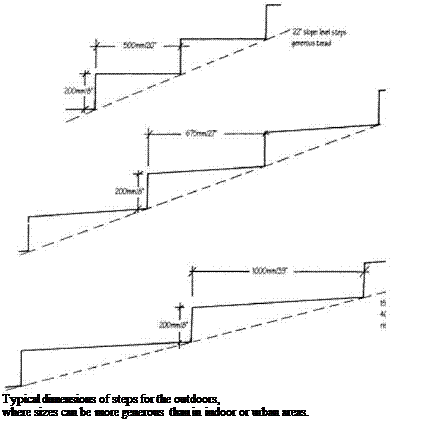This can be used in a number of ways. One version to be avoided is the use of round or half-round timber as edge retainers. These offer no grip, and under wet conditions they are extremely slippery and dangerous.
Steps have frequently been constructed of stout sawn boards laid on their edges to form a small retaining structure behind which hardcore or crushed stone is laid. These are dangerous, as the stone is liable to settle, wash out or collect water, causing the edge of the timber to stand proud and trip people, especially on their way down. If the wood is too narrow it can wear down quite quickly. These should not be used.
Solid timber steps work best. These have often been constructed from old railway sleepers (railroad ties), which are of almost perfect dimensions when laid flat and sawn to length. There can be problems of pollution due to the leaching of certain preservatives such as creosote from the sleepers, which precludes their use in some places. Nevertheless, the same dimensions can be sawn from solid wood, but such steps tend to be expensive unless local rough logs can be used. Durable timber for use where preservatives are not possible includes cedar, oak and some eucalypts.
Any form of timber steps can be held in place by stout pegs or short stakes driven into the subsoil. Slots or notches for the pegs can be cut in the front edges of the steps to make a neater finish. If the steps overlap each other, a strip of timber along the underside near the front edge can help to hold them in position (see diagram). These steps are placed on excavated bases, on a layer of crushed stone to aid drainage and give a firmer support.
 |
Alternatively, timber steps can be built as self-contained step structures similar to open staircases, perhaps placed against a low rock cliff or up a steep bank. Well-constructed, sturdy sections such as this can be anchored down and placed on rock bases to keep them clear of the soil to reduce rot. In the steepest of such steps a handrail up the side is desirable (see ‘Handrails’ below).



